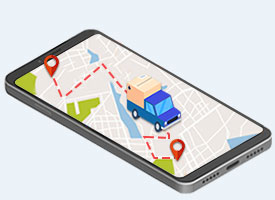Difference between Shipping and Delivery
In general, there is a minor difference between shipping and delivery. In most cases, they both represent the designated final destination for the delivery of your product and both are used comprehensively while administering an Ecommerce business. Companies and retailers must use both services with marked differences to avoid customer complaints, inconvenience, and disappointment, and we should be clear about letting our customers know what their shipping and delivery dates are to avoid complaints from unhappy customers if their item is time-sensitive.
Shipping and delivery are two terms that are synonymous with each other. If anyone shops online, the product company gives them two dates: the shipping and delivery date, which in terms have two meanings in logistics and with e-commerce taking stage in today’s world.
What is a Shipping Barcode?
A shipping barcode is a unique combination of bars and spaces that represents a specific shipment in the shipping industry. The barcode is printed on a label, which is then attached to the shipment or its packaging. When a barcode scanner reads the barcode, the system can automatically track the shipment's movement through the shipping process.
They are an essential part of the shipping process and are used by both carriers and customers to track the movement of shipments.
-
A unique shipping barcode is generated for each shipment, which can be done using barcode software.
-
The barcode is printed on a label and attached to the shipment or its packaging.
-
When the shipment is received by the shipping carrier, the barcode is scanned to update the system with the shipment's details, including its origin, destination, weight, and dimensions.
-
The shipping carrier can use the barcode data to monitor the progress of the shipment, update customers on its status, and generate reports on shipping performance.
-
Shipping barcodes are widely used in the shipping industry as they can help to improve efficiency, reduce errors, and provide real-time tracking information to customers.
-
As the shipment moves through the shipping process, the barcode is scanned at various checkpoints to track its movement and ensure that it is delivered to the correct destination.
We’ve outlined the definition of shipping v/s delivery, so let us look at the significance of the two:
Shipping is the time, day, or date when the products leave the supplier’s warehouse. If the seller tells you that the product they sold you is shipped, it means that it is already on its way to you. It typically refers to when an item has left the warehouse of the supplier and is ready for the next stage, which is delivered to the customer. This process involves loading products onto vehicles or ships and transporting them to a distribution warehouse. Shipping can be a complex process, and it is important to choose the right mode of transportation for each type of good and consider sending small items to the customers that can be sent using the local postal service or the best courier service, like FedEx.
Delivery is when the product reaches the end-user. This delivery stage refers to getting the goods transported to its final destination, which is the customer’s doorstep. The delivery signifies the time, day, or date when the buyer gets the goods they have purchased, and this can be done by many modes of transportation, including planes, trains, and boats.
Future of barcode technology in the shipping industry, and how will it continue to improve package delivery?
As barcode technology continues to advance, we can expect to see even more efficient scanning and tracking of packages, leading to faster and more accurate delivery. The future of barcode technology in the shipping industry is likely to see continued growth and evolution, with innovations that improve package delivery in several ways:
-
Integration with other technologies:
Barcode technology is already being used in conjunction with other technologies such as GPS tracking and real-time data analytics. In the future, we can expect to see even more sophisticated integrations that provide even greater visibility and control over the shipping process.
-
Expansion of use cases:
While barcode technology is already widely used in the shipping industry, we can expect to see even more use cases and applications in the future. For example, barcodes could be used to track and manage inventory in warehouses, or to monitor the condition of perishable goods during transport.
-
Integration with customer service:
Barcode technology can also be used to improve customer service by providing customers with real-time updates on the status of their packages, as well as easy access to information about delivery times, locations, and other important details.
How to Track Shipping and Delivery Products?
Barcodes are an important factor in the entire order delivery process. Modern shipping and logistics would be incomplete without them, and they are helpful in reducing shipping errors.
Managing and shipping large numbers of orders can be quite difficult to track without barcode technology. In the absence of a barcode system like this to track packages, keeping track of products and orders would be impossible, but with barcodes, you can track shipments to the tiniest details accurately.
Barcode systems are used in inventory stores as part of the items' purchase and return processes, in warehouses, and fulfillment centers. It is also helpful for tracking inventory and packages, by courier companies to locate and track shipments, and at times on invoices to help with accounting.

